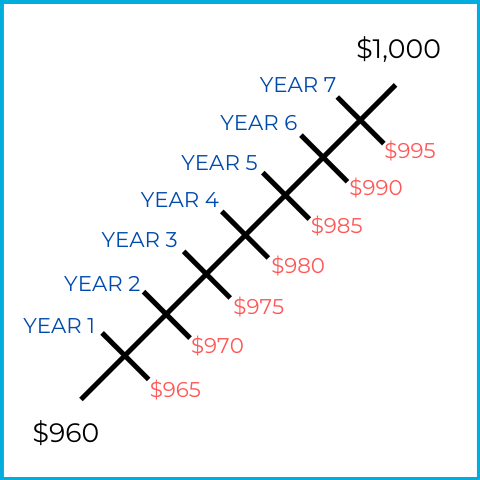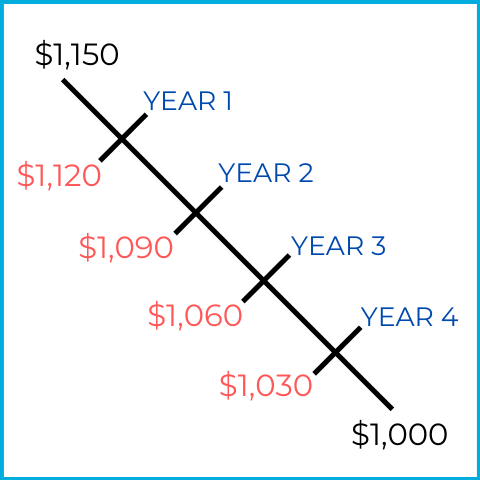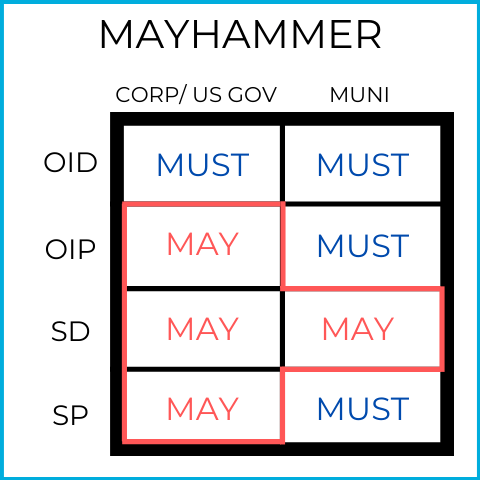Bonds pay interest, which for most bonds is taxable in some way (unless it’s a municipal bond). When a bond is purchased at a discount or premium, additional tax liabilities or benefits may exist. In this section, we’ll discuss how discounts are accreted and premiums are amortized.
Accretion refers to bond investors paying an annual tax on bond discounts. Let’s explore an example:
An investor purchases a 5-year, $1,000 par, 6% corporate bond for 95.
In this scenario, the investor bought a bond at $950, which results in them gaining a $50 discount over 5 years (if held to maturity). The investor’s annualized discount is $10 per year ($50 / 5 years), for which they must pay taxes in addition to the $60 (6% coupon) of annual interest. Although it feels like a capital gain, the IRS considers the discount additional interest income. If the bond was held to maturity, their tax liability would look something like this:
| Year | Taxable interest | Accreted discount | Total taxable interest |
|---|---|---|---|
| 1 | $60 | $10 | $70 |
| 2 | $60 | $10 | $70 |
| 3 | $60 | $10 | $70 |
| 4 | $60 | $10 | $70 |
| 5 | $60 | $10 | $70 |
When an investor accretes their bond, they pay taxes on the discount annually. In some circumstances, investors have the choice of accreting. If an investor doesn’t accrete a discount bond, they wait until the end of the bond to pay taxes on the discount. If this was the scenario, the tax liability would look like this:
| Year | Taxable interest | Non-accreted discount | Total taxable interest |
|---|---|---|---|
| 1 | $60 | $0 | $60 |
| 2 | $60 | $0 | $60 |
| 3 | $60 | $0 | $60 |
| 4 | $60 | $0 | $60 |
| 5 | $60 | $50 | $110 |
When an investor chooses not to accrete their bond, they wait until maturity (or when they sell the bond) to pay for the taxes on the discount. It’s the same amount of tax liability, but the timing is different. In this scenario, the investor has a $60 interest tax liability for four years, then a $110 interest tax liability in the final year. We’ll discuss in what circumstances investors have the choice of accreting or not later in this section.
Regardless of whether a bond is accreted or not, the bond’s cost basis rises by the annualized discount annually. If the bond is held to maturity, there is no capital gain or loss. Remember, the discount is considered additional interest income. A capital gain or loss can only occur if the bond is sold prior to maturity. Let’s take a look at an example to better understand this:
An investor purchases a 5-year, $1,000 par, 6% corporate bond for 95. At the end of 3 years, the investor sells the bond at 96. If they choose to accrete the bond, what are the tax consequences that year?
First, let’s lay out the answer:
Because the investor accreted the bond, they’ll pay taxes on the annual interest ($60) plus the annualized discount ($10). That’s how we get to $70 of taxable interest income.
To better understand the $20 capital loss, look at this visual:

Every year, the bond’s cost basis will rise by the amount of the annualized discount ($10), regardless of whether the bond is accreted or not. After 3 years, the bond’s cost basis is $980, while the sales proceeds are $960, leading to a $20 capital loss. Although the bond was originally bought for $950, its cost basis goes up every year. It’s confusing, but it’s the way the tax rules work. Let’s see if you can tackle an example on your own:
An investor purchases $1,000 par, 4% debenture with 8 years to maturity at 96. At the end of 5 years, the investor sells the bond at 99. If they do not accrete the bond, what are the tax consequences that year?
Because the investor did not accrete the bond, they’ll pay taxes on the discount at the end of the bond (when the bond is sold). The investor has been paying taxes on $40 (4% coupon) of interest annually, which is the foundation for the tax liability in year 5. When the bond is sold, the investor must pay taxes on the annualized discount relating to the number of years they held the bond. With a $40 discount over 8 years, the annualized discount is $5. The investor held the bond for 5 years, so they’ll have a tax liability equal to the taxable coupon interest ($40) and the annualized discount for 5 years ($5 x 5 years = $25). Therefore, the taxable interest income is $65 overall.
Let’s take a look at a visual that represents the cost basis:

Every year, the bond’s cost basis will rise by the amount of the annualized discount ($5). After 5 years, the bond’s cost basis is $985. The bond’s sales proceeds are $990, which leads to a $5 capital gain.
Amortization refers to reducing taxable interest annually due to losing money on a bond premium. Let’s explore an example:
An investor purchases a 5-year, $1,000 par, 6% corporate bond for 105.
In this scenario, the investor bought a bond at $1,050, which results in losing a $50 premium over 5 years (if held to maturity). The investor’s annualized premium is $10 ($50 / 5 years), for which they can reduce taxes on the $60 (6% coupon) of annual interest they receive. Although the premium feels like a capital loss, the IRS factors it into interest income. If the bond was amortized and held to maturity, their tax liability would look something like this:
| Year | Taxable interest | Amortized premium | Total taxable interest |
|---|---|---|---|
| 1 | $60 | $10 | $50 |
| 2 | $60 | $10 | $50 |
| 3 | $60 | $10 | $50 |
| 4 | $60 | $10 | $50 |
| 5 | $60 | $10 | $50 |
When an investor amortizes their bond, they reduce taxable interest annually. In some circumstances, investors have the choice of amortizing. If an investor doesn’t amortize a premium bond, they wait until the end of the bond to reduce taxable interest. If this was the scenario, the tax liability would look like this:
| Year | Taxable interest | Non-amortized premium | Total taxable interest |
|---|---|---|---|
| 1 | $60 | $0 | $60 |
| 2 | $60 | $0 | $60 |
| 3 | $60 | $0 | $60 |
| 4 | $60 | $0 | $60 |
| 5 | $60 | $50 | $10 |
When an investor chooses not to amortize their bond, they wait until maturity (or when they sell the bond) to reduce taxable interest. In this case, the investor has a $60 interest tax liability for four years, then a $10 interest tax liability in the final year. We’ll discuss what circumstances investors can choose in the next section (see below).
Regardless of whether the investor amortizes the bond or not, the bond’s cost basis falls by the annualized premium annually. Remember, if the bond is held to maturity, there is no capital gain or loss. The premium is factored into the bond’s interest income. A capital gain or loss can only occur if the bond is sold prior to maturity. Let’s take a look at an example to better understand this:
An investor purchases a $1,000 par, 7% Treasury bond with 4 years to maturity at 108. At the end of 2 years, the investor sells the bond at 101. If they amortize the bond, what are the tax consequences that year?
Can you figure it out?
Because the investor amortized the bond, they’ll pay taxes on the annual interest ($70) minus the annualized premium ($20). That’s how we get to $50 of taxable interest income.
To better understand the $30 capital loss, look at this visual:

Every year, the bond’s cost basis will fall by the amount of the annualized premium ($20), regardless of whether the bond is amortized or not. After 2 years, the bond’s cost basis is $1,040, while sales proceeds are $1,010, leading to a $30 capital loss.
Let’s try one last example:
An investor purchases a $1,000 par, 13% mortgage bond with 5 years to maturity at 115. At the end of 4 years, the investor sells the bond at 107. If they do not amortize the bond, what are the tax consequences that year?
Because the investor did not amortize the bond, they’ll reduce their taxable annual interest ($130) by four years of the annualized premium ($30 x 4 years = $120). That’s how we get to $10 of taxable interest income.
To better understand the $40 capital gain, look at this visual:

Every year, the bond’s cost basis will fall by the amount of the annualized premium ($30), regardless of whether the bond is amortized or not. After 4 years, the bond’s cost basis is $1,030, while sales proceeds are $1,070, leading to a $40 capital gain.
As we’ve discussed, investors can factor in a bond’s discount or premium into their taxes annually if they accrete or amortize, or choose to wait until the end of the bond. Sometimes it’s the choice of the investor, and sometimes they are forced to accrete or amortize. This visual sums up the IRS rules you need to know:

The “mayhammer” is a great resource to memorize for the exam. Do you see the red hammer? In certain circumstances, investors have the choice of accreting/amortizing or not (may). In other circumstances, the investor must accrete or amortize, meaning they’ll have to factor in the bond’s discount or premium into their annual taxes. A typical exam question on this topic could look like:
Which of the following statements are false?
A) New issue corporate bonds sold at a discount must be accreted
B) New issue municipal bonds sold at a discount must be accreted
C) New issue corporate bonds sold at a premium must be amortized
D) New issue municipal bonds sold at a premium must be amortized
Do you know the answer?
Answer = C
Using the “mayhammer,” you’ll find answer choices A, B, and D all to be correct. Each of these bonds must accrete or amortize the premium annually.
A new issue corporate bond sold at a premium (OIP) is a “may,” meaning the investor has the choice of deducting the annualized premium annually (amortizing) or waiting until the end of the bond to take the full deduction.
Municipal bonds are known as tax-free bonds, but they don’t completely avoid taxes. In particular, there are two circumstances where a municipal bond could be taxed.
When a municipal bond is purchased in the secondary market at a discount, the discount is fully taxable. While the interest is tax-free (if a residency exists or territory bond), the discount is taxable just as we discussed previously. However, this does not apply to new issue municipal bonds bought at a discount (it’s tax-free).
If a municipal bond is sold prior to maturity at a gain (similar to what we previously discussed), a tax liability could occur. Municipal bonds accrete and amortize the same way as the other bonds we discussed above. If there’s a capital gain at the sale, it’s fully taxable. If there’s a capital loss at the sale, it’s potentially deductible (like any other capital loss).
When a municipal bond is purchased at a premium, the amortized premium is not deductible against municipal bond interest. Think about it - municipal bond interest is generally tax-free, so there’s nothing to deduct against. Keep in mind this is different from locking in a capital loss, which is deductible against earned income.
Sign up for free to take 17 quiz questions on this topic